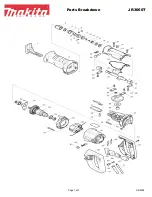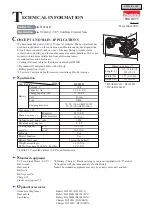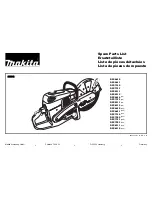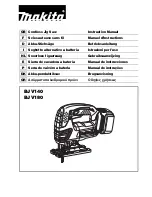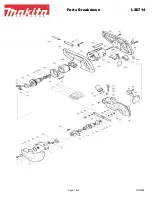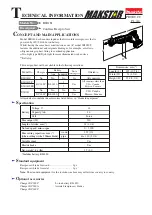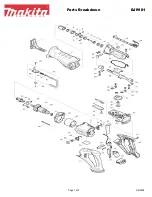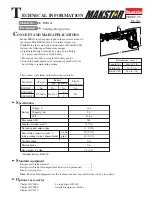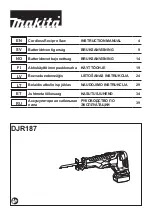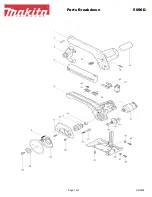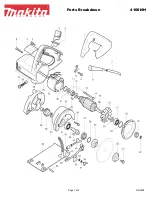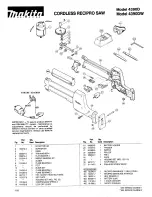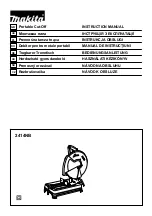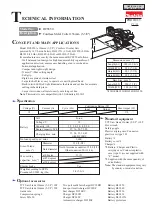
ing the lower guard up and the saw blade teeth dug into the scrap wood.
8. AFTER INSTALLING THE SAW BLADE, REPOSITION GUARD BRACKET MAKING SURE IT
IS FULLY SEATED ON GUARD SCREW. FIRMLY TIGHTEN SCREW. FAILURE TO DO SO
WILL CAUSE SERIOUS DAMAGE TO THE SAW.
Adjustments
PERFORM ALL ADJUSTMENTS WITH THE MITER SAW UNPLUGGED!
NOTE:
Your miter saw is fully and accurately adjusted at the factory. If readjustment is
required, follow the steps listed to adjust your saw.
PIVOT BOLT ADJUSTMENTS
Adjustments to the pivot bolt may be required as wear occurs. Adjustment must be made with the
saw fully assembled, including the blade. Loosen or tighten the pivot bolt by turning the hex head
located on the left side of the pivot assembly until nearly all play is removed and the motor moves
up smoothly when released.
BLADE TO FENCE SQUARENESS:
Perform the steps listed:
NOTE:
After adjustments, blade may not align with slot in table top.
1. With the saw unplugged, lower the pivot arm until tip of saw blade is even with top of saw
table. Blade should appear to be parallel to the sides of the slot. It is not important that the
blade be perfectly centered to the slot, but more importantly it should be reasonably paral-
lel. See Figure 4.
If the blade appears to be parallel, proceed to "miter pointer adjustment" below. If not,
loosen (do not remove) the two bolts under the back edge of the saw table that hold the
pivot arm (see Figure 5) to the saw. Align the blade as necessary and tighten the bolts (23-
27 ft. lbs.). (DO NOT OVERTIGHTEN)
2. Check the squareness of the blade to the fence using a square. If the blade checks OK,
then saw is ready for use.
3. If blade and fence are not square (90°), the saw must be adjusted.
To adjust the squareness, loosen the two handle bar bolts, which are located underneath
the saw in the middle of the rotary table, (Figure 7). DO NOT REMOVE THESE BOLTS.
With the handle bar bolts loose and the rotary base set in the zero position, align the
blade square to the fence, (Figure 6).
Tighten the handle bar bolts (23-27 ft. lbs.) and your saw should be properly adjusted.
MITER POINTER ADJUSTMENT
TURN OFF TOOL AND DISCONNECT FROM POWER SUPPLY.
1. Loosen the miter clamp knob and squeeze the miter latch to move the miter arm to the 0
position, as shown in Figure 8.
2. With the miter clamp knob loose, allow the miter latch to snap into place as you rotate the
miter arm past 0.
3. Observe the pointer and miter scale through the viewing opening. If the pointer does not
indicate exactly 0, use a flat bladed screwdriver to gently push it left or right as required.
Guard Actuation and Visibility
The blade guard on your saw has been designed to automatically raise when the arm is
brought down and to lower over the blade when the arm is raised. The guard can be raised by
hand when installing or removing saw blades or for inspection of the saw. NEVER RAISE THE
BLADE GUARD MANUALLY UNLESS THE SAW IS TURNED OFF.
Switch
To turn the saw on, depress the trigger switch- Figure 9. To turn the tool off, release the switch.
There is no provision for locking the switch on, but a hole is provided in the trigger for insertion
of a padlock to lock the saw off.
Cutting with Your Saw
NOTE:
Although this saw will cut wood and many nonferrous materials, we will limit our dis-
cussion to the cutting of wood only. The same guidelines apply to the other materials.
DO NOT
CUT FERROUS METAL (IRON AND STEEL) OR MASONRY MATERIALS WITH THIS SAW.
Do not
use any abrasive blades.
Set the miter arm at the desired angle. Be sure to tighten the miter clamp knob and hold the
wood on the table and firmly against the fence. Turn on the saw by squeezing the trigger switch
shown in Figure 9.
When the saw comes up to speed (about 1 second) lower the arm smoothly and slowly cut
through the wood. Let the blade come to a full stop before raising arm.
Quality of Cut
The smoothness of any cut depends on a number of variables. Things like material being cut,
blade type, blade sharpness and rate of cut all contribute to the quality of the cut.
When smoothest cuts are desired for molding and other precision work, a sharp (60 tooth or
greater) carbide blade and a slower, even cutting rate will produce the desired results.
Ensure that material does not creep while cutting, clamp it securely in place. Always let the
blade come to a full stop before raising the arm.
If small fibers of wood still split out at the rear of the workpiece, stick a piece of masking tape
on the wood where the cut will be made. Saw through the tape and carefully remove tape when
finished.
For varied cutting applications, refer to Table 2. Select the blade that best fits your needs.
Body and Hand Position (Figure 10)
Proper positioning of your body and hands when operating the miter saw will make cutting
easier, more accurate and safer. Never place hands near cutting area. Place hands no closer than
6" (153mm) from the blade. Hold the workpiece tightly to the table and the fence when cutting.
Keep hands in position until the trigger has been released and the blade has completely stopped.
ALWAYS MAKE DRY RUNS (UNPOWERED) BEFORE FINISH CUTS SO THAT YOU CAN CHECK
THE PATH OF THE BLADE. DO NOT CROSS HANDS IN FRONT OF BLADE AS SHOWN IN
FIGURE 10.
Keep both feet firmly on the floor and maintain proper balance. As you move the miter arm left
and right, follow it and stand slightly to the side of the saw blade.
Support for Long Pieces
TURN OFF TOOL AND DISCONNECT FROM POWER SUPPLY.
Support long workpieces using any convenient means, such as sawhorses or similar devices to
keep the ends from dropping.
Special Cuts
NEVER MAKE ANY CUT WITHOUT FIRMLY CLAMPING THE MATERIAL. ALWAYS USE PROPER
BLADE.
ALUMINUM CUTTING
Aluminum extrusions such as those used when making aluminum screens and storm windows
can easily be cut with your saw. Position the material so that you will be cutting the thinnest
cross section, as shown in Figure 11. Figure 12 illustrates the wrong way to cut these extrusions.
Use a wax lubricant when cutting aluminum such as Johnson’s Stick Wax No. 140. Apply the
stick wax directly to the saw blade before cutting. Never apply stick wax to a moving blade.
The wax, available at most hardware stores and industrial mill supply houses, provides proper
lubrication and keeps chips from adhering to the blade.
BOWED MATERIAL
When cutting bowed material always position it as shown in Figure 13. Positioning the materi-
al incorrectly will cause it to pinch the blade near the completion of the cut.
CUTTING PLASTIC PIPE
Plastic pipe can be easily cut with your saw. It should be cut just like wood and
clamped or held
firmly to the fence to keep it from rolling.
45
25
20
15
10
5
0
5
10
15
20
25
30
35
40
35
40
30
DUST CHUTE
FENCE
LOCK DOWN PIN
TABLE
UPPER GUARD
SWITCH
SWITCH HANDLE
MOUNTING FOOT
MITER HANDLE
MITER LATCH
SPECIFICATIONS
120 Volts
1152 Watts
60 Hz
12 Amps
ORIFICE D'ÉVACUATION DE LA POUSSIÈRE
GUIDE
TIGE DE VERROUILLAGE
PROTECTEUR SUPÉRIEUR
INTERRUPTEUR
POIGNÉE D'INTERRUPTEUR
PATTE DE MONTAGE
POIGNÉE POUR ONGLETS
DISPOSITIF DE VERROUILLAGE POUR ONGLETS
TABLE
CANAL PARA POLVO
GUIA
PERNO DE TRABADO
MESA
GUARDA SUPERIOR
INTERRUPTOR
MANIJA DEL INTERRUPTOR
PIE DE MONTAJE
ASA ANGULAR
SEGURO DE ANGULO
FICHE TECHNIQUE
120 volts
1152 watts
60 Hz
12 A
ESPECIFICACIONES
Tensión de alimentación:
120 V~
Potencia nominal:
1152 W
Frecuencia de operacion:
60 Hz
Consumo de corriente:
12 A
A
1
2
3
4
5
6
45
25
20
15
10
5
0
5
10
15
20
25
30
35
40
35
40
30
7
8
9
45
25
20
15
10
5
0
5
10
15
20
25
30
35
40
35
40
30
45
25
20
15
10
5
0
5
10
15
20
25
30
35
40
35
40
30
10
45
25
20
15
10
5
0
5
10
15
20
25
30
35
40
35
40
30
11
APPLICATION
BLADE
DESCRIPTION
NO. OF
TEETH
TYPE
OF CUT
Fine Trim
Molding
Trim, Framing
Pressure Treated
Decking
Aluminum
Precision
Ground Carbide
Combination
Multi-Purpose
Non-Ferrous
Metal Cutting
Carbide
60-100
32-60
60-80
Very Smooth
Splinter Free
Smooth
Fast Cut
—
Table 2
12
13
0
5 10 1
5 2
0 2
5
30
35
40
4
5
45
40
35
30
25
20
15
10 5
Содержание 1710
Страница 8: ......









